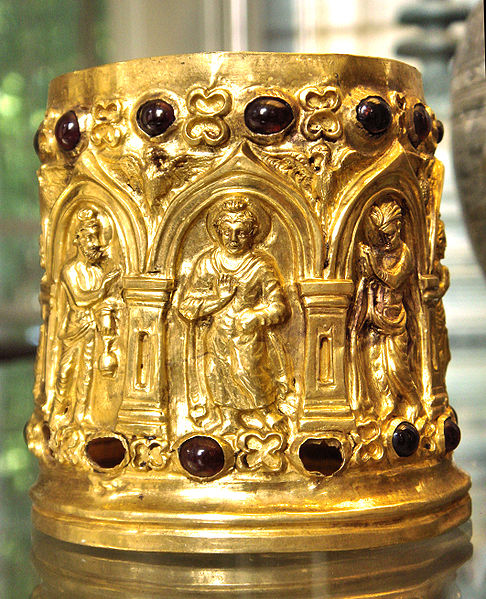Tathāgata is a Pali and Sanskrit word; Gautama Buddha uses it when referring to himself or other Buddhas in the Pāli Canon. Likewise, in the Mahayana corpus, it is an epithet of Shakyamuni Buddha and the other celestial buddhas. The term is often thought to mean either "one who has thus gone" (tathā-gata), "one who has thus come" (tathā-āgata), or sometimes "one who has thus not gone" (tathā-agata). This is interpreted as signifying that the Tathāgata is beyond all coming and going – beyond all transitory phenomena. There are, however, other interpretations and the precise original meaning of the word is not certain.
Tathagata, Shakyamuni Buddha in a thangka painting showing the avadana legend scenes.
Beyond all coming and going: the Tathāgata
"The Seven Buddhas", at Sanchi (1st century BCE/CE). Six Buddhas of the past are represented, together with the current Buddha, Gautama Buddha, with his Bodhi Tree (at the extreme right). In the central section are three stupas alternating with four trees with thrones in front of them, adored by figures both human and divine. These represent six Buddhas of the past (viz. Vipassī Buddha, Sikhī Buddha, Vessabhū Buddha, Kakusandha Buddha, Koṇāgamana Buddha, and
Siddhartha Gautama, most commonly referred to as the Buddha, was a wandering ascetic and religious teacher who lived in South Asia during the 6th or 5th century BCE and founded Buddhism. According to Buddhist legends, he was born in Lumbini, in what is now Nepal, to royal parents of the Shakya clan, but renounced his home life to live as a wandering ascetic. Buddhists believe that after leading a life of mendicancy, asceticism, and meditation, he attained nirvana at Bodh Gaya in what is now India. The Buddha then wandered through the lower Indo-Gangetic Plain, teaching and building a monastic order. Buddhist tradition holds he died in Kushinagar and reached parinirvana, final nirvana.
Statue of the Buddha, preaching his first sermon at Sarnath. Gupta period, c. 5th century CE. Archaeological Museum Sarnath (B(b) 181).
The Buddha, Tapa Shotor monastery in Hadda, Afghanistan, 2nd century CE
One of the earliest anthropomorphic representations of the Buddha, here surrounded by Brahma (left) and Śakra (right). Bimaran Casket, mid-1st century CE, British Museum.
Māyā miraculously giving birth to Siddhārtha. Sanskrit, palm-leaf manuscript. Nālandā, Bihar, India. Pāla period







